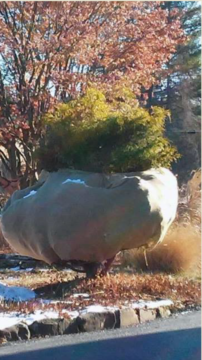Now is the time to prepare you garden for the Winter months.
Caring for your trees and shrubs during the winter season will ensure a healthy and happy plant in the Spring. Here are a few tips on keeping your plantings well-maintained and beautiful for seasons to come.
Japanese Maples and thin barked trees
In the Winter months Deciduous trees and shrubs drop their leaves and go to sleep. They stop performing their processes and become dormant, but the harsh effects from wind and ice are the two most important factors to keep in mind when protecting your trees. Tree wrap is used to prevent sunscald injury which usually occurs during winter and early spring. Intense sunlight warms the surface of the trees to the point of stimulating cell activity in the bark, then a sudden drop in temperature at night can cause damage to the tree resulting in the condition known as sunscald. One way to prevent this, is by applying tree wrap in November. Start at the bottom of the trunk, overlapping the wrap as you wind it upward. Secure the end with a staple or small tack. In April, remove the wrap so insects or diseases aren’t tempted to move in. An easy way to remember: wrap by Thanksgiving and unwrap by Easter.
Evergreens
Some younger evergreens (while they establish themselves) and particular specimen may need some protection over the harsh Winter months to keep them healthy and at their top grade. In order for Evergreens to retain their beautiful color, they must continue executing their processes (photosynthesis) for the Winter months albeit they perform at a much slower rate. Which means that the tree will need access to moisture, making dehydration and excessive transpiration a particular issue. If there hasn’t been much rain over the Fall season be sure to supplement, it is necessary to do it before the ground freezes otherwise the tree will not be able to absorb the water into the roots. Establishing an extensive root system can help allow the tree access to deeper ground level moisture, as well as putting mulch down in the Fall, as there is limited moisture in the frozen ground.
Windburn is one particular problem, it dries out the plant and the leaves on an evergreen. The leaves or needles will turn brown and die, this usually happens in the beginning of Spring when the ground is still frozen and the winds are still chilling but the warmth is causing the trees to start waking up, producing the need for more moisture. Any practice that promotes good root growth will help the plant meet its water needs.  This can also be prevented by wrapping your trees in burlap, they can be wrapped individually or by making a screen. The burlap is used to protect from wind, sun, and salt residue it is best to leave the top open to allow for light. It is important to use a type of wrap that “breathes” and allows light and water in for the essential needs of the plant.
This can also be prevented by wrapping your trees in burlap, they can be wrapped individually or by making a screen. The burlap is used to protect from wind, sun, and salt residue it is best to leave the top open to allow for light. It is important to use a type of wrap that “breathes” and allows light and water in for the essential needs of the plant.
In late fall, when temperatures maintain an average above 40 degrees, you can also spray foliage of evergreen shrubs and small trees with an anti-transpirant such as Wilt-Pruf of Vapor Guard which provides a waxy layer that cuts down on water loss and minimizes winter injury. The spray needs to be reapplied during our spring thaw as well. It is best to apply on a day when the leaves can dry properly, ideally a sunny day, and ensure that the leaves top and bottom are thoroughly covered. Other precautions are avoiding placing susceptible plants where they will be exposed to wind. Any browned or dead areas of the tree, that have occurred over the winter, should be pruned back in the spring. New foliage will grow to fill in any gaps left by removing dead branches and foliage.
Pottery & Fountains
While this high density mixture is designed to produce a strong and durable product, proper maintenance is recommended to protect our product from the freeze-thaw cycles that occur in winter. Any piece which can hold water, snow or ice, such as a planter, birdbath/ fountain top or shell, and any piece which is placed directly on the ground surface, such as a statue, birdbath/fountain base, planter or bench leg, can be damaged by the winter freeze-thaw cycles.
Pump Care – The fountain relies heavily on the quality of the pump. A well-maintained pump can last several years.
Step 1 – Fully submerge: Ensure the pump is fully submerged at all times to avoid damage.
Step 2 – Ensure water level is sufficient: Check water levels regularly as water may evaporate over time, and periodically change water to avoid algae
buildup.
Step 3 – Clean pump: Use soap and water, or white vinegar and water, with a small, soft brush to clean the pump of debris, dirt, and algae buildup.
This should be done every 2-3 months.
Surface Care – Paints and finishes may fade over time due to weathering. By following these tips, you will be able to maintain your fountain’s surface.
Step 1 – Control Algae and White Scale: Due to water evaporation, you may see white residue on your fountain surface from the mineral content in
your water supply. Algaecides and cleansers can help prevent buildup that occurs from minerals and hard water.
Step 2 – Protect and Refinish: Depending on the material of your fountain, protectants and sprays may prolong the appearance of the surface. Paint and
refinishing kits can be used for touch-up.
Winter Care – Many materials used to produce fountains can expand and contract in different temperatures/humidity levels. If the temperature falls below
32°F or humidity levels change drastically, follow the steps below to protect your fountain.
Step 1 – Bring inside: If possible, bring your outdoor fountain inside for the winter.
Step 2 – Store in dry location: If unable to bring inside, store your fountain in a dry and covered location.
Step 3 – Bring components inside: Move all internal components (stoppers, tubing, lights, pump, etc) inside. A pump can stay in a fountain for the
winter, but if you choose to leave it in, it must be completely dry and insulated with plastic bags and towel to ensure it stays dry. However it is
recommended to bring it inside.
Step 4 – Completely drain: It is important to prevent water from accumulating anywhere, as freezing and thawing of water can cause pump damage
and cause cracks to form in your fountain. Remove the drain plugs.
Step 5 – Elevate Fountain: Fountains may freeze to the ground and cause cracking in the base if left outside in the winter. If unable to store inside or in
a dry covered location, try to raise your fountain above ground.
Step 6 – Cover Fountain: Make sure to use a breathable material when covering. DO NOT COVER IN PLASTIC! Make sure the fountain cover is taut so
that no snow or water can pool in the cover. Tie the opening at the bottom of the cover around the fountain.
Cast Stone & GFRC Planters – If a planter is to be left planted over the winter, it should be raised up off the ground by placing two (2) pressure treated wood strips underneath the planter, making sure not to block the drainage hole. Attractive pot risers sold by Campania may also be used for this purpose. This will allow the soil to drain and will prevent the planter from freezing to the ground. If a planter is placed directly on the ground and goes through several freeze-thaw cycles, drainage may be blocked. This may cause an expansion of the soil inside the planter, which in turn may cause the planter to crack or crumble. We always recommend that drainage materials such as small stones or terra cotta chips be placed at the bottom of the planter before filling with soil to ensure proper drainage. If a planter is not to remain planted over the winter, we suggest that it be stored in a covered area where it will be protected from the elements. If a planter must be left outside unplanted, we suggest that it be emptied and turned upside down onto wood strips. It should then be covered or wrapped with burlap or any absorbent material (old blanket/towel) and then wrapped with dark plastic. This will prevent moisture from accumulating in the planter. Please note that even if a cast stone container is raised off the ground, there is always the risk that the container will absorb water through its surface which, when frozen, can cause the planter to crack or break.






